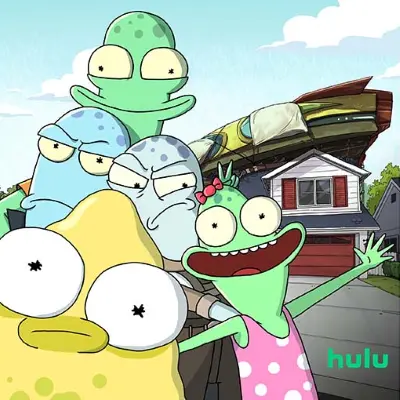Solar Opposites creators didn't intend to be political or prescient with their Wall
-

On Justin Roiland and Mike McMahan's Hulu animated alien series, “The Wall" is a terrarium that the high school misanthrope Yumyulack (Sean Giambrone), Korvo’s “replicant,” has filled with the miniaturized bodies of people he dislikes. "When we started writing Solar Opposites, we weren’t paying attention to politics," says McMahan. "This was pre-2016. This was before I knew the name of everybody in the cabinet and who the secretary of the Treasury is, and I think we’re all, maybe against our own best wishes, our own wishes, more political than we used to be. And what we originally were trying to build in the Wall is, we wanted something that felt comfortably serialized in a mythologically broad and storytelling way — where you understand that when communities are created in a crisis that heroes and villains rise. We grew up seeing stories like that. You see that with, like, you said, Lord of the Flies. I would say, Under the Dome or Escape From New York. It’s a very sci-fi sort of sensibility." Roiland adds that "it was so funny to Trojan horse that dramatic human story into this crazy comedy," prompting McMahan to respond: "Sorry we accurately predicted this weird proto-fascist era with our Wall story. That was our bad."
ALSO:
- Why Season 2 goes into some darker, more misanthropic places with the characters: "I think mostly we just don’t want to cover ground we’ve already covered," says co-creator Mike McMahan. "The first season was this chaotic, fun, silly thing. And then second season, we’re like, okay, what else can we do with these characters and what other kind of marital family regular plots can get turned into weird alien plots? And I think it maybe came out dark; I mean, the Wall specifically, we knew we wanted to do a murder detective story instead of a rising of a rebellion. So that was always going to be a little bit darker. But there was no going into the season being like, “let’s make it darker,” at least not from my side."
- What is the difference between Rick and Morty fans and Solar Opposites fans?: "I think from what I’ve seen with Rick and Morty, at this point, Solar fans are like Season 1 Rick and Morty fans," says McMahon. "When we first made Rick and Morty we saw people would find Rick and Morty and they would want to share it with their friends. They’d be like, 'You’ve got to see this. This is f*cking good.' Now Rick and Morty is so invasive, so many people have told their friends to watch it that Rick and Morty’s almost like, it’s become this thing that’s bigger than what it is. Everybody kind of knows about it."
- Solar Opposites goes on chaos autopilot in Season 2: "Chaos and destruction is baked into the greater Rick & Morty/Solar Opposites ethos at this point (as will almost certainly be the case for Koala Man)," says Steve Greene. "So it’s not all that surprising to see so many of these Season 2 episodes devolve into the central figures just getting destroyed in matter-of-fact style. Nothing against alien hell beasts ripping through city infrastructure with reckless abandon, but when it becomes the default, there’s less and less to latch onto with each passing adventure. But even when it’s on autopilot, there’s still a reveling in visual detail that’s consistently a reason to keep watching. The suburban color palette is the background against which all of these destructive quests play out, but any time a Shlorpian pulls out a weapon that anthropomorphizes inanimate objects or reorganizes the molecular structure of rats, all those consequences fly by in a hail of purples and oranges and blues that do really shine. The sheer number of tiny component parts that make up life inside The Wall point to an incredible amount of effort of both design and execution that pay off in every frame."
TOPICS: Solar Opposites, Hulu, Justin Roiland, Mike McMahan
More Solar Opposites on Primetimer:- Solar Opposites' Damage Control Worked, But Should It Be So Easy to Separate an Abusive Creator From Their Show?
- Billions' Power Players Aim for World Domination in the Final Season
- New Allegations Reveal Justin Roiland Created a Toxic Work Environment From the Start
- Vampires, Werewolves, and Jack Osbourne: Our Guide to the Best of Halloween TV 2022
